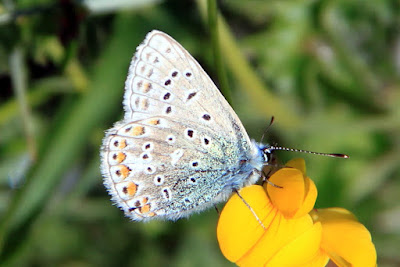North Devon is wonderful - rolling hills and deep valleys with lush woodlands, sunken lanes lined with foxgloves and the beautiful coast with cliffs and sand-dunes in equal measure - what's not to like.
Local style of drystone wall
Red campion and umbellifers growing on a wall top
As you walk along the coast (in this case around Morthoe - which incidentally has a fab camp site!), the quiet fields often support permanent pasture grazed by sheep and hay meadows.
Local grazers
The sheep don't eat the foxgloves (probably due to the digitoxin which may kill them) so these stand bolt upright in splendid isolation. They create quite a picture.
Foxgloves and windblown tree
Paths weave their way down to the beach and seashore, providing rich corridors for wildlife. On this occasion there were dozens of speckled wood butterflies vying for a territory.
Path to the cliffs
Blackbird trying to dent the insect population
Many beaches are large expanses of flat sand with only the odd struggling jellyfish washed up. However there are also many small inlets with rockpools and rough beaches - these are what the real wildlife enthusiast heads for.
Steps down to the beach
The cliffs present one of the very few natural habitats in Britain. Their unstable nature, and exposure to salt and winds, means that in many areas only the hardy maritime specialist plants thrive, such as the pink thrift, the blue sheep's bit and sea plantain. These are often joined by vetches, such as the yellow flowered kidney vetch.
Rich cliff flora
Kidney vetch
On areas of almost bare rock another set of plants such as hawkbits and sedum species grow.
Rock flora
Of course the seashore also supports many thrilling breeding birds such a fulmars, gulls and this oyster-catcher, with its shrill, piping alarm call.
Oystercatcher
Rock pipit
Rock pipits, jackdaws and the odd raven can also be seen. If you are really lucky, you may see peregrine falcons swooping past as they chase after doves or other birds. I saw one with food in its talons.
Down on the beach, the where the tide has receded and left pools behind, there are often rich pickings if you spend the time looking. Small fish called Blennies are common inhabitants of the larger pools, as are sea anemones and shrimps. Of course there is a myriad of shellfish such as limpets, cockles, winkles and periwhinkles.
A blenny
The layers of seaweed hanging from the rocks, or those still immersed in the pools, can be easily overlooked. However many are very colourful and have an interesting structure, such as the fucus species with its bladders to keep it upright when in the water.
Brown fucus seaweed
Colourful seaweeds - spot the shrimp
Under every piece of seaweed there are sand hoppers and under almost every sizeable rock there seems to be a crab.
Shore crab
This is just a taster of the rich diversity that our wonderful coast offers - so try to get down there at least once this season.


















































